
In this way, the market competition environment is very fierce, then for lithium battery, it requires higher and higher precision. Now, here, one Zmotion motion controller "ZMC432" is mainly introduced, specifically, ZMC432 SS Curve application on high-precision welding.
Multiple motors can work at together through one ZMC432 EtherCAT bus controller, and it can meet synchronous control requirements between multi-axis and multi-workplace processing in lithium battery welding industry.
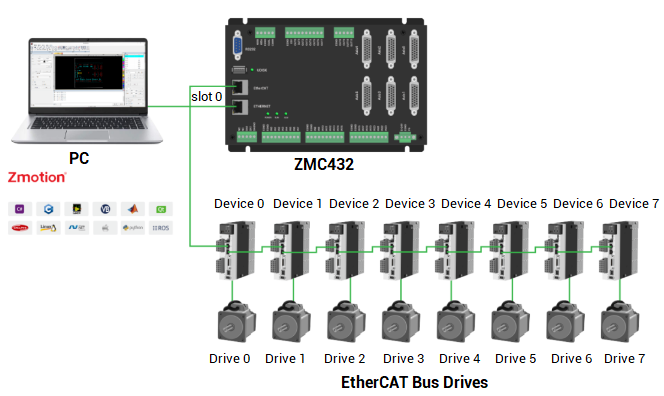
Z
M
O
T
I
O
N
ZMC432 is one multi-axis high-precision EtherCAT bus motion controller developed by Zmotion. This controller has rich communication interfaces, they are EtherCAT, EtherNET, RS232, CAN, UDISK, etc. , and it can be seen it belongs to ZMC series motion controllers, this series can be used in all kinds of occasions that need offline or online.
ZMC432 controller supports 32 axes motion control at most, then achieves many functions, linear interpolation, any circular interpolation, space arc, helical interpolation, electronic cam, electronic gear, synchronous follow.
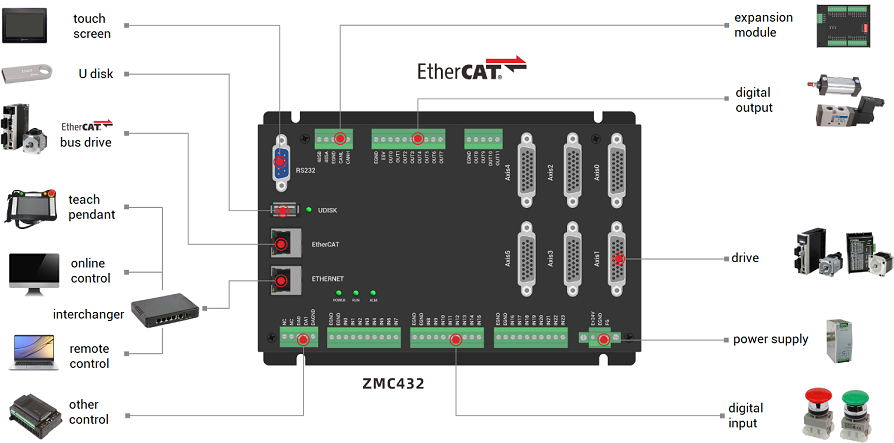
The programming method must be mentioned, ZMC432 support three kinds of programming methods, PLC, Basic and HMI. For PC host computer API programming, it supports C#, C++, LabVIEW, Matlab, Qt, Linux, VB.Net, Python, ect.

ZMC432 is multi-axis high performance controller that reaches lots of functions, basic functions are introduced, now, let's see one important function in high-precision welding application.
High-precision PSO position synchronization output is built inside the ZMC432, when there is deceleration in fillet and curve processing motion, this function can ensure equal-space output of laser energy in high-speed processing.
But the condition is ? or how to achieve ?
Through commands, HW_PSWITCH2, MOVE_HWPSWITCH, HW_TIMER and others all are used to realize hardware comparison output PSO.
For example, when doing the fillet processing of lithium battery welding, the output spacing can be kept constant while decelerating, and the SS curve processing technology is combined to increase the process flexibility. It not only ensures the processing effect, reduces mechanical vibration, but also maximizes production capacity.
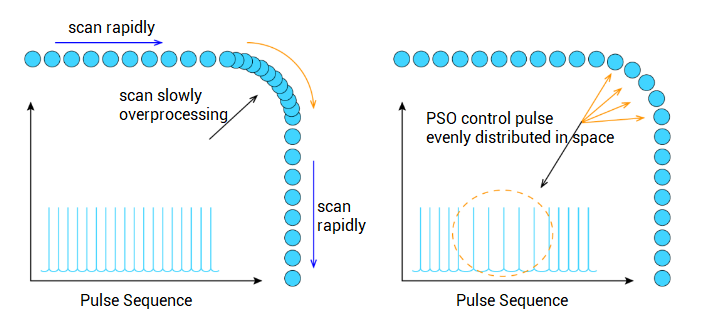
Common motion curves are ladder (T) speed curve and S speed curve. Actually, Zmotion developed one another speed curve based these two, SS Speed Curve.
Next, show one by one for you.
(1) Ladder speed curve
This kind of curve also can be called T curve, which is used to express the relationship between the speed and the time. As shown below, there are 3 stages for standard ladder speed curve, constant acceleration, constant and constant deceleration stages.
Therefore, in interpolation motion, use Basic instructions directly to set speed parameters (SPEED, ACCEL, DECEL) when axis parameters are initializing.
This kind of curve is applied extremely widely because of fastest planning and simple usage in motion control.
Simple and fast correspond to not so smooth, and the corner acceleration is not consecutive, then easily cause machine shake in actual interpolation.
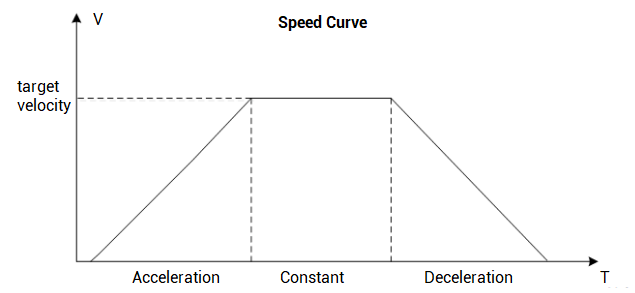
(2) S speed curve
Also, S speed curve is used to show speed and time relationship. The difference is this will process smooth in acceleration and deceleration stage, then the curve shape looks like "S", please refer to below graphic.
In actual motion application, there is one specified instruction "SRAMP" provided by Zmotion Basic language, using it to set corresponding value for reducing shakes in control process, then the speed curve in motion will be smoother.

The grammar of SRAMP: VAR1 = SRAMP, SRAMP = smoothms.
smoothms: millisecond unit, the acceleration and deceleration process will extend the corresponding time after setting, the length of time that can be set and the actual extension time of acceleration and deceleration are related to distance, speed, and accel.
(3) SS speed curve
SS speed curve is also named as jerk curve. Similarly, it displays the speed and the time.
But what is it exactly ?
In fact, it is the physical quantity that describes acceleration changes, namely, change ratio of acceleration.
It is developed by Zmotion, including the Basic commands, "VP_MODE", it can be used to achieve SS curve through mode 6 and mode 7.
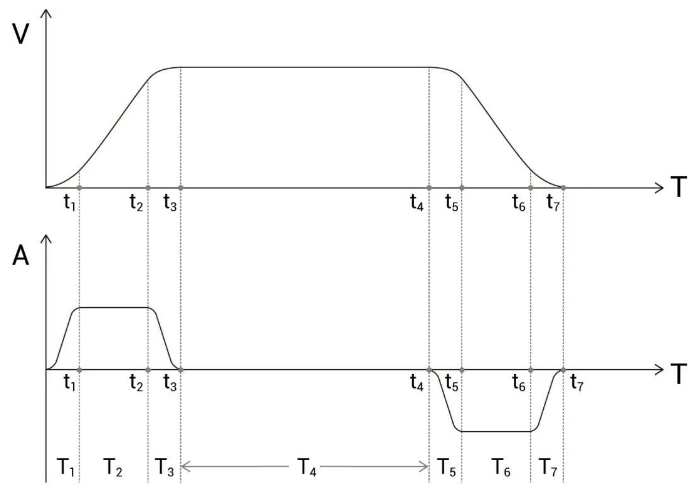
After the jerk is smoothed, in some high-precision motion industrial applications, the phenomenon of excessive shock and vibration caused by the rapid acceleration rate of the mechanism can be reduced.
For example, in the common lithium battery welding processing industry, when performing track welding on the top cover of the power battery, applying SS curves to it in each corner chamfering motion can effectively increase the flexibility, and reduce machine vibration and impact, making the welding process more stable and continuous.
As mentioned above, the trapezoidal velocity curve has only three stages, uniform acceleration, uniform velocity and uniform deceleration.The S-shaped curve can be divided into 7 stages because the acceleration and deceleration stages are smoothed, as shown in the figure below, the range of action of the S-curve is T1, T3, T5, and T7, the range of action of the SS curve is also the same, the difference is that the SS curve acceleration changes more smoothly.
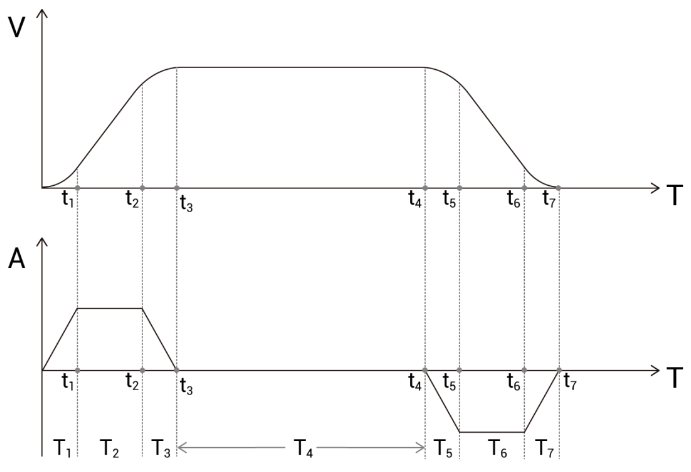
Then, how jerk come out?
In acceleration and deceleration process, acceleration is changeable, one new variable is needed, "J" -- jerk.
J=da/dt
In the acceleration changes, the maximum acceleration is defined as a max, the minimal is -a max, in this way, the relationship between acceleration and jerk in each stage is:
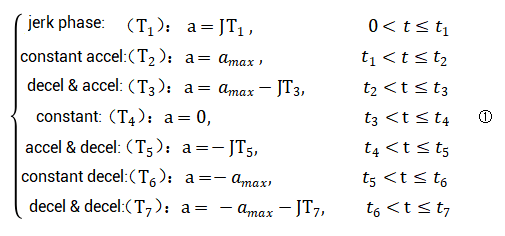
Generally, 3 basic system parameters are required to determine the whole running process.
(1) acceleration and time relation
According to the acceleration change curve in the above figure, it can be seen that T1-T3 is the constant acceleration stage, T4 is the constant acceleration stage, and T5-T6 is the constant deceleration stage , and there is another variable μ:

Depend on above two formulas, functional relationship between acceleration and speed should be:
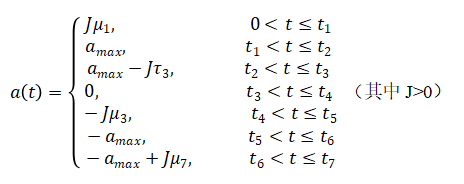
(2) speed and time relation
The functional relationship between speed and acceleration is: v=at, then the relationship between jerk and speed satisfies:

Combined with the acceleration time relationship and the above acceleration and time relationship function, the following relationship can be obtained:
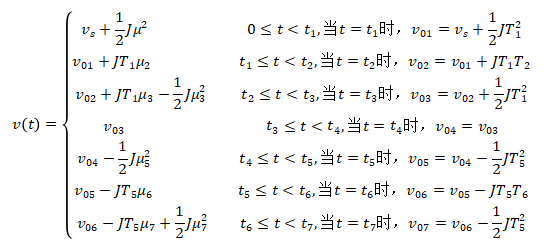
After simplification, we get:
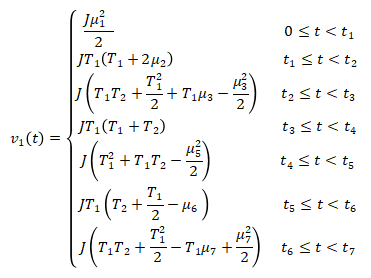
That's all for the functional relationship among the curve changes among speed, acceleration and jerk.
(1) Introduction
The acceleration and deceleration curve type can be set through the VP_MODE command. And there are multiple modes to choose, S-curve and SS curve can be set to make the trapezoidal curve smoother. This instruction is generally used in the axis parameter initialization program and can be used together with the SRAMP instruction. When VP_MODE is mode 0, the value set by SRAMP takes effect.
Syntax: VAR1 = VP_MODE or VP_MODE(axis)=mode
mode: mode selection
The VP_MODE mode is as follows.
--Mode 0--
By default, use SRAMP to set the S-curve.
--Mode 4--
The maximum acceleration is at the start, and the acceleration gradually becomes 0 when the maximum speed is reached. The S and SS curves are shown below.
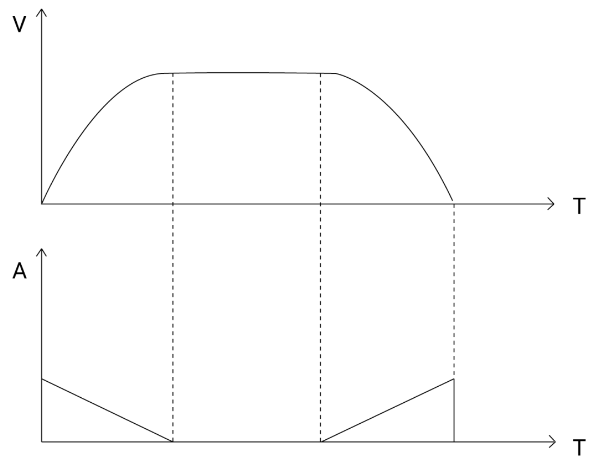
This mode is suitable for high-speed start-stop processing occasions that do not require impact.
--Mode 6--
A new type of SS curve, a curve type with continuous jerk, SS mode will increase the deceleration time by 87% compared with T-shaped deceleration. This mode only takes effect in the deceleration phase, and the acceleration phase takes effect in mode 0, which is convenient for continuous small line segment interpolation.
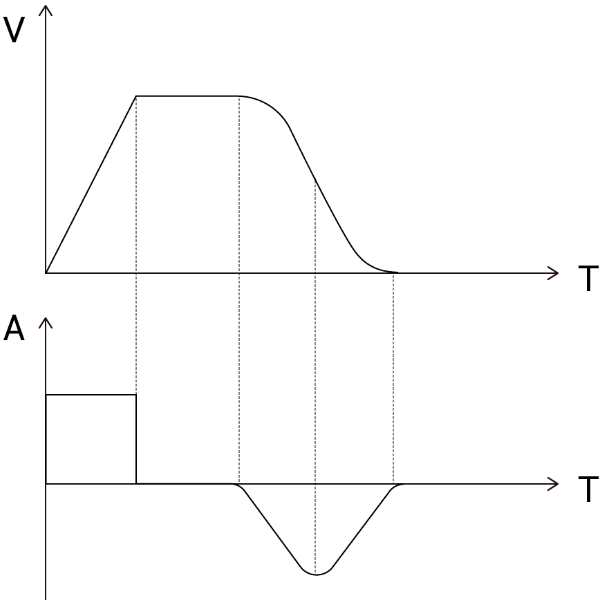
This mode is suitable for processing occasions where the machine starts at high speed and stops smoothly.
--Mode 7--
New type SS curve, curve type with continuous jerk. Dynamically modifying the axis parameters or continuous interpolation may cause the jerk to be uncontinuous. At this time, it will switch to mode 0, so it is recommended that SRAMP also set an appropriate value.
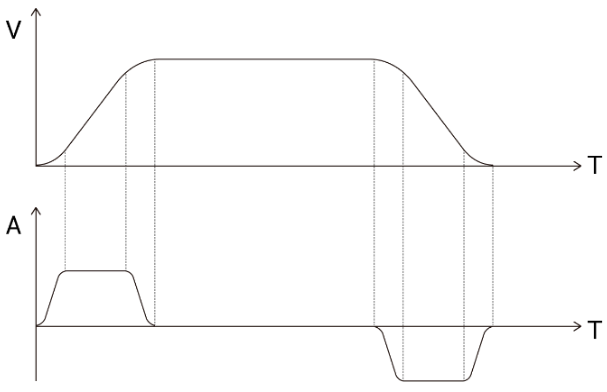
This mode is suitable for shock-free processing occasions with high precision and stable start-stop speed.
(2) Examples & Routines
Following all routines can be achieved through ZMC432 controller.
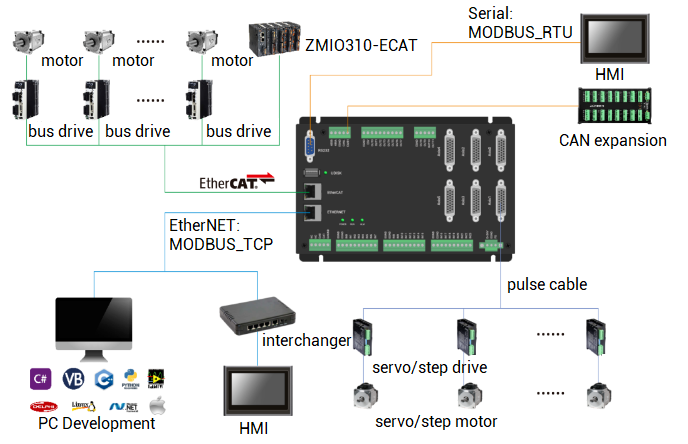
--set VP_MODE as mode 0, take the single-axis motion as the example--
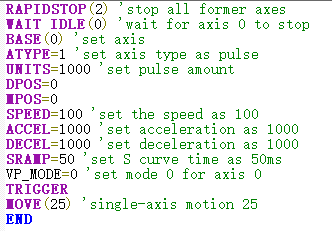
When SRAMP=50, the speed and acceleration curves are shown in the figure below, which are smoothed in the acceleration and deceleration phases respectively, and the movement time will be extended accordingly. It can be compared with the graph when SRAMP=0.
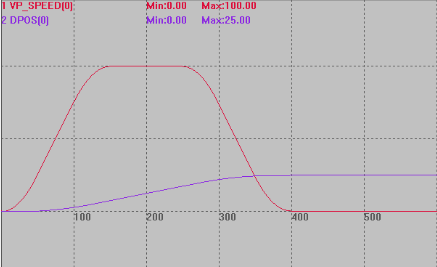
When SRAMP=0:
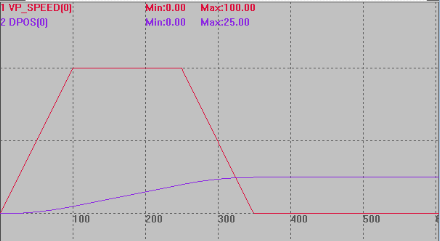
--set VP_MODE as mode 4, take multi-axis linear interpolation as the example--
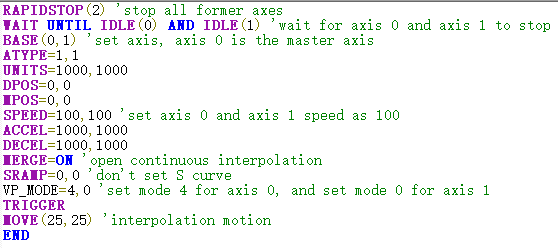
Under the above configuration, axis 0 adopts VP_MODE mode 4, starts to move with the highest acceleration and decreases to 0. This mode is suitable for occasions requiring quick start and stop.
Note: since this movement is an interpolation movement, axis 0 is the main axis, so the speed and acceleration curves can be based on the main axis. The VP_ACCEL data source needs to be manually input to collect changes in acceleration values under the S-curve and SS-curve.
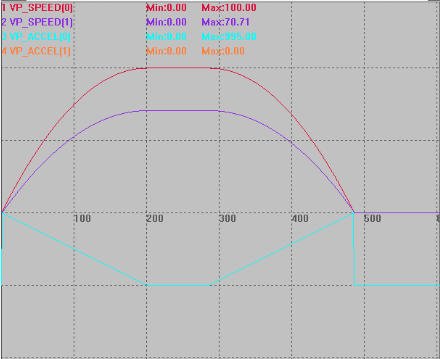
--set VP_MODE as mode 6, take multi-axis linear interpolation as the example--
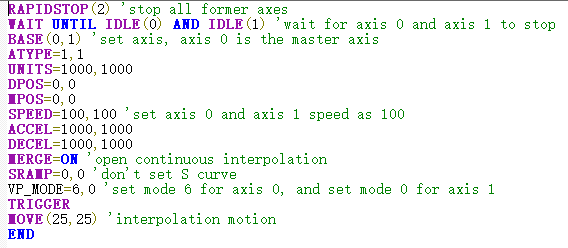
When VP_MODE is set to mode 6, only the deceleration phase is smoothed. When the S or SS curve is not set during the acceleration phase, the acceleration will reach the maximum value at the moment of power-on, and it will move with the set acceleration. When the SS curve is set in the deceleration phase, it can be seen from the figure below that the acceleration curve is decelerated smoothly, making the motion transition more natural and smooth during the deceleration phase.
This mode is suitable for continuous interpolation occasions to improve efficiency while ensuring smooth motion.
Note: since this movement is an interpolation movement, axis 0 is the main axis, so the speed and acceleration curves can be based on the main axis.
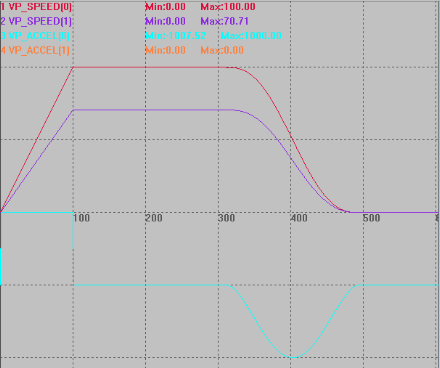
--set VP_MODE as mode 7, take track processing in lithium battery industry as the example--
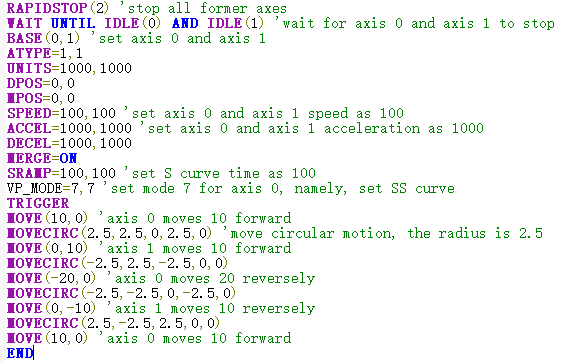
VP_MODE is set to mode 7, and the image after smoothing the SS curve is as follows, which can be compared with the VP_ACCEL acceleration curve (light blue line) in the figure below. It is suitable for occasions with large motion jitter.
Note: since this movement is an interpolation movement, axis 0 is the main axis, so the speed and acceleration curves can be based on the main axis.
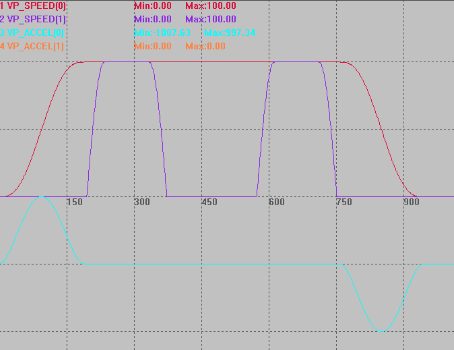
Interpolation trajectory of axis 0 and axis1 under XY mode:
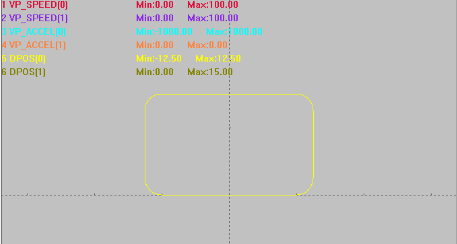
--SS curve is not set--
SRAMP=100,100 'set S curve time as 100
VP_MODE=0,0 'cancel SS curve
It can be seen from the sampled waveform, it moves according to current S curve.
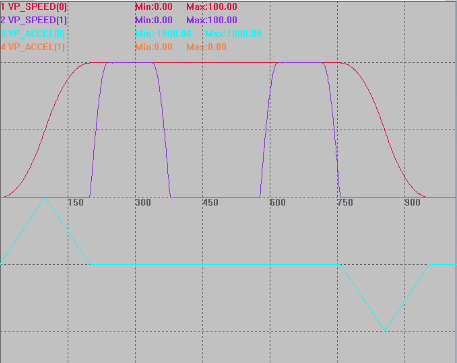
From this, it can be compared that VP_MODE=7, the speed curve of SS acceleration and deceleration of axis 0 and axis 1 is softer.
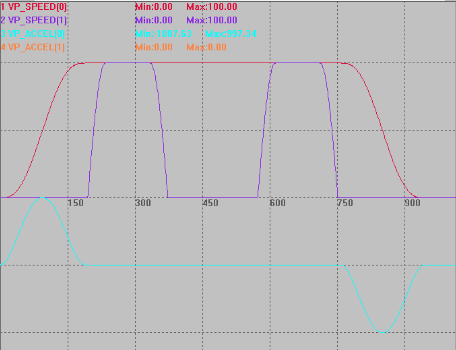
ABOUT ZMOTION
That's all, thank you for your reading -- Zmotion Motion Control Lithium Welding Application: High & Soft SS Curve
For more information, please pay close attention to "Support" and "Download" , and there are other platforms about Zmotion - Youtube & LinkedIn & Twitter & Tiktok & Facebook, including technical information (development environment, routine code), product showing, company development, etc.
Hope to meet you, talk with you and be friends with you. Welcome!
This article is edited by ZMOTION, here, share with you, let's learn together.
ZMOTION: DO THE BEST TO USE MOTION CONTROL.
Note: Copyright belongs to Zmotion Technology, if there is reproduction, please indicate article source. Thank you.
Zmotion Technology focuses on development of motion control technology and general motion control products, it is a national high and new technology enterprise. Due to its concentration and hard work in motion control technology, ZMOTION already become one of the fastest growing industrial motion control companies in China, and is also the rare company who has managed core technologies of motion control and real time industrial control software completely. Here, Zmotion provides motion controller, motion control card, vision motion controller, expansion module and HMI. In addition, there is one program software developed by Zmotion -- ZDevelop. It is a good choice for you to program and compile. And program through upper computer, there is PC manual.
Zmotion Technology provides motion control card, motion controller, vision motion controller, expansion module and HMI. ( more keywords for Zmotion: EtherCAT motion control card, EtherCAT motion controller, motion control system, vision controller, motion control PLC, robot controller, vision positioning...)
Have a good day, best wishes, see you next time.